![]()
As the name suggests, the Platform Exit Signal controls the exit from a "Platform Track" (Danish: "Perronspor"), i.e. Station tracks that can hold a train being stopped for operational purposes like exchange of passengers, a meet or to be overtaken. There need not actually be a platform in the track to fit the definition. The Platform Exit Signal is typically placed before the switch zone at the end of the station:

Whether the track section from the Platform Exit Signal to the Exit Signal constitutes a separate block varies with the line-type. On single track (due to relatively light traffic) or where the Platform Exit Signal to Exit Signal distance is short, the Platform Exit Signal cannot clear before the Exit Signal clears, i.e. in reality making the Exit Signal obsolete. On some stations this has led to the Exit Signals being placed at the end of the platform tracks and on some not, depending on which considerations has ranked higher when resignaling has been carried out. Either configurations have their pros and cons but a discussion of these is outside the scope of this document.
Platform Exit Signals can be duplicated along a platform track. The duplication may serve only to repeat the outermost Platform Exit Signal in case of bad oversight, and/or to section the platform track into short blocks:

Platform Exit Signals need not be placed inside the switch zone alltogether:




The leftmost Platform Exit Signal appearance is by far the most common. The signal is mounted at the engineer's eye level and equipped with a background plate to aid visibility. Platform Exit Signals without the background plate are found at locations with tight clearances and in other instances where the background plate has been considered unnecessary. Ground level Platform Exit Signals are quite rare and are mostly found in the oldest installations, in places with tight clearances and low speeds.
Where local conditions does not require all lamps in a Platform Exit Signal, signals without the obsolete lamps are installed. The most common types are:




The two leftmost signals will typically be Platform Exit Signals at the end of a platform track on a smaller station without switching routes. As the red lamp is mandatory today, the first example is only found in older installations. The third example is typically an inner Platform Exit Signal in an older installation where the red lamp was not necessary for exit route signaling. The rightmost example is rare but is found where no main routes lead away from the platform track.
Platform Exit Signals may have a supplemental Route Destination Indicator, Reduced Speed Sign or a Numerical Speed Indicator.
 |
 |
 |
 |
|
|
X | X | X | X |
 |
 |
 |
 |
|
|
X | X | X | X |
 |
 |
 |
 |
|
|
X | X | X | X |
 |
 |
 |
 |
|
|
X | X | X | X |
 |
 |
 |
 |
|
|
X | X | X | X |
 |
 |
 |
 |
|
|
X | X | X | X |
 |
 |
 |
 |
|
|
X | X | X | X |
|
X | X | ||
|
X | X | ||
|
X | X | X | X |
|
X |
 |
 |
 |
 |
|
|
X | X | X | X |
|
X | X | ||
|
X | X | ||
|
X | X | X | X |
|
X |



Given the technology and functional requirements of the time, there was no differentiation between the entry route and the safety overlap; They were all part of the same locking. When Dwarf Signals were introduced, matters became more blurred. A Dwarf Signal at the end of a Platform Track, i.e. at the "normal stopping location", would show "No Passing", effectively forbidding the train to proceed further. The Dwarf Signal thus became the marker of the end point of the entry route, while the Exit Route Signal still had no real saying in this respect. This situation resulted in the new Platform Exit Signal adopting the "No Passing" indication when marking the end point of an entry route:


Not all entry routes extended to the Switch Limit, though this was the rule. To emphasize the end point of entry routes with a "less safe" overlap (i.e. not extending to the Switch Limit), the Platform Exit Signal was able to show "Stop". Since "Stop" was only to be used with entry routes requiring special caution, the same Platform Exit Signal would show different aspects depending on the safety overlap:


Since 1975 it has been standard for Platform Exit Signals to show "Stop" when marking the end point of an entry route, regardless of the type of safety overlap. Engineers consider it an advantage to have the end point of the entry route clearly pointed out amongst the white lights from other signals. The signal shows "Stop" until the safety overlap is released by a timer. There are, however, still many signals following the old rule.
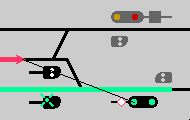
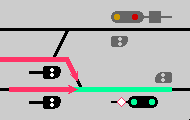
The Borup incident wasn't the first of its kind where an engineer was looking one signal too far ahead. It was decided to have all Platform Exit Signals giving Flank Protection to an Exit Route show "Stop" instead of "No Passing". This extra display of "Stop" is often referred to as "Borup Red". The red "Stop" aspect helps emphasize the signal, compared to the more neutral double white "No Passing":
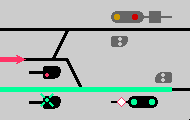
In some installations all Platform Exit Signals for the direction in question show "Stop" when an Exit Route is set. This is an implementation shortcut common in older interlockings where "Borup Red" was not implemented from the start.
A Platform Exit Signal is basically a signal at the end of a platform track, controlling trains in the platform track. When visibility of this signal is bad, more Platform Exit Signals are added along the platform track. The "inner" Platform Exit Signals act as repeater signals for the outermost Platform Exit Signal. Instead of using special repeater signal aspects,. the Platform Exit Signal uses the ordinary aspects.
In the example below, a total of 3 Platform Exit Signals has been placed in the platform track. The outermost (rightmost) Platform Exit Signal is the ordinary signal while the others are repeaters:

When the inner Platform Exit Signals only act as repeater signals, there is only one possible entry route to the track, extending to the outermost Platform Exit Signal. This outermost signal shows "Stop" (or "No Passing" as outlined above) to mark the end point of the entry route. The inner Platform Exit Signals are basically unnecessary in this situation. To still permit the train to proceed to the end of the track, the inner Platform Exit Signals show the "Pass" aspect, otherwise only used for switching moves:

In this simple type of Platform Exit Signal installation, any failure (faulty track circuit for instance) that prevents the Entry Signal from showing "Proceed" will result in the inner Platform Exit Signals showing "Pass with Caution" instead of "Pass":

The repeater signals are really only necessary when trains are to depart the Station, since the permission to do so must be visible to the engineer. Again the outermost Platform Exit Signal will act as if it was the only Platform Exit Signal in the track and display "Proceed" or "Proceed Through", depending of the state of the signals ahead. The repeater Platform Exit Signals simply repeats this signaling:


Since the inner Platform Exit Signals are just simple repeaters, all signals will show the same aspect, regardless of where the departing train is located in the platform track:

When an inner Platform Exit Signal is used as the end point of an entry route, Platform Exit Signal behavior is similar to the long entry route:


Platform Exit Signals beyond the entry route end point are unaffected by the route set. The signal aspect shown by the Entry Signal reflects the shorter entry route. In the examples above, the middle Platform Exit Signal is approached at "Low Speed" (40 km/h, 25 mph) while the entry route to the innermost Platform Exit Signal is a route without safety overlap.
When the Platform Exit Signals are handled as individual signals as shown above, their behavior in failure situations also reflect the problem more closely:

Exit route signaling can basically be done in two ways. Either an exit route can be set all the way from the innermost Platform Exit Signal, regardless of the actual position of the train, or from the signal immediately ahead of the train:


Setting the exit route from an inner signal can be desirable due to CTC having limited possibilities for route setting or due to the need to lock, say, switches between the front of the train and the Platform Exit Signal.
Simultaneous entry routes to inner Platform Exit Signals and exit routes from outer Platform Exit Signals are mutually excluded, to avoid the risk of an engineer seeing an outer signal at "Proceed" or better and overlooking his/her own signal at "Stop".


On stations with Exit Block Signals, things get a little more complicated. It is a basic Danish philosophy that "Proceed Through" from a Station signal means that the route is clear to the Switch Limit (Exit Signal) and that the train may proceed onto the line. Therefore a Platform Exit Signal may not show "Proceed Through" even though a following Exit Block Signal shows "Proceed":



When exiting towards Wrong Main track:

When crossing from one main track to another through a low-speed crossover on a bidirectional line:
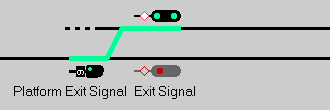
Where the characteristics of two exit routes differ significantly. This use has become very common since the introduction of ATC, since the ATC can only distinguish exit routes by reading the "Proceed"/"Proceed Through" aspect (i.e. it cannot read Route or Speed Indicators which might in some cases be a help):

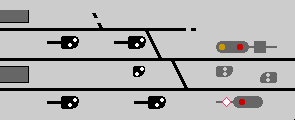
Canceling of signals is mostly used in smaller areas of stations. In the example below, the (interlocked) siding is released for local switching by canceling the Platform Exit Signals. The crossover to the Through Tracks is not released, providing protection for signaled routes on the rest of the station:
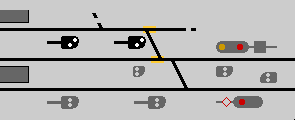

If the interlocking dates back before "Stop" was mandatory to mark the end point of an entry route, the Platform Exit Signal is only able to show "No Passing" and "Proceed Through" to trains:


In addition to this, the Platform Exit Signals can be canceled as a group to permit local switching:


The line is primarily signaled for right-hand running, with special Wrong Main Signals for the occasional left-hand running. Further descriptions of this type of double track signaling can be found here . The Station has a siding (upper track) for trains to be overtaken. For the purpose of the example the Platform Exit Signals have been supplemented by simple repeater signals.
Entry route signaling is typically as outlined above; the innermost Platform Exit Signal showing "Pass" and the outermost signal (the end of the entry route) showing "Stop". Entry routes to the siding may have an alternate choice of routing the safety overlap back to the right main track.
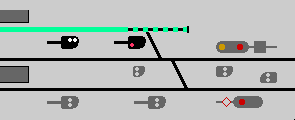
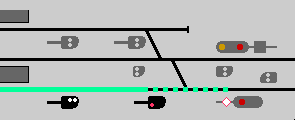
Exit or through routes to the right main track use simple advance signaling functions, i.e. "Proceed" if the Exit Signal is at "Stop" and "Proceed Through" if the Exit Signal shows "Proceed" or better:
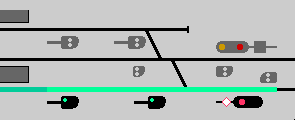
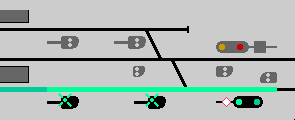
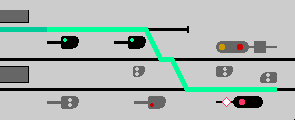

When exiting towards wrong main track "Proceed" is used to indicate caution. This is an example of the use of "Proceed" on an inferior exit route, even thought the Platform Exit Signal cannot clear until the Wrong Main Exit Signal shows "Proceed":
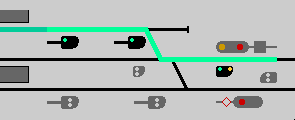
The example below shows a Station, from which it is possible to proceed onto a single track line (top) and a double track line (bottom). Since exit to both lines is only possible from track 1 (top), only the outer most Platform Exit Signal in track 1 is equipped with a Route Indicator:
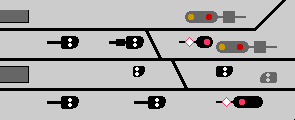
Platform Exit Signals show "Proceed" or "Proceed Through" following the above mentioned guidelines. The Platform Exit Signal aspect is supplemented by the Route Destination Indicator letter:
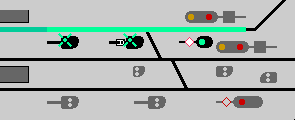

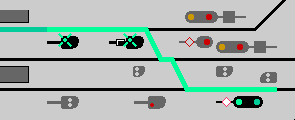
Installation of ATC has meant the demise of advance signaling on secondary Exit Routes as described above. In the example shown, exit towards Right Main on the double track would only be signaled as "Proceed", regardless of the state of the signal ahead:
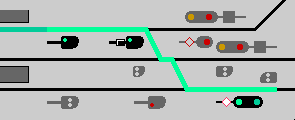
When exiting towards Wrong Main, the appropriate letter symbol for the line is shown, together with the usual "Proceed" from the Platform Exit Signal:
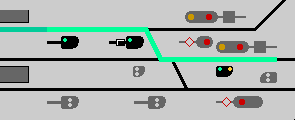
Bi-Directional running could not safely work with the traditional lack of speed and route signaling when exiting stations. This was remedied by adding Speed Boards or Speed Indicators to Platform Exit Signals. Initially all Platform Exit Signals, that might lead a train to a Bi-Directional Multiple Track, were to be equipped with Speed Indicators. Due to the large number of repeater signals and the large number of signals from which exit speed was not variable, it was decided for cost reasons to add Reduced Speed Signs to Platform Exit Signals from which exit speed was fixed. All Platform Exit Signals in tracks with variable exit speed were to be equipped with Speed Indicators. Speed Indicators would repeat the signal ahead in a manner similar to the Platform Exit Signal repeater function. In cases where a signal would justify a Route Indicator and a Speed Indicator, it was decided only to install a Speed Indicator.
In the example below, track 1 (top) and track 3 (bottom) both have fixed exit speeds. From track 1 exit speed is 50 km/h (30 mph) due to the diverging switch, and from track 3 there is only one possible Exit Route at 90 km/h (55 mph). From track 2 (middle) it is possible to proceed onto both Bi-Directional Tracks and thus track 2 signals must be equipped with a Speed Indicator able to indicate 50 km/h and 90 km/h:

When exiting on a route permitting High Speed (80 km/h, 50 mph, or more), the Platform Exit Signals will show "Proceed" or "Proceed Through" depending of the state of signals ahead:
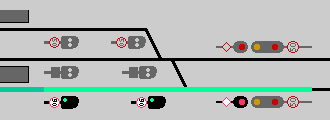
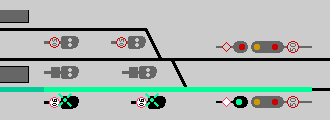
A Speed Indicator will show the permitted speed divided by 10, i.e. "9" for a permitted speed of 90 km/h:
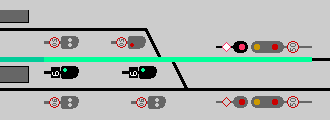
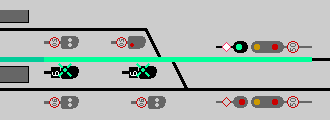
When exiting from a track with variable exit speed, on a route not permitting High Speed, the Platform Exit Signal will only show "Proceed", regardless of the state of the signal ahead:
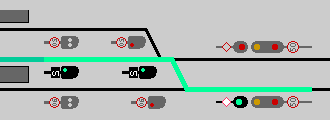
When exiting from a track with fixed exit speed lower than High Speed, there are two different approaches. On lines without Automatic Train Control (ATC), the Platform Exit Signals cannot show a more favorable indication than "Proceed", regardless of the state of the signal ahead:
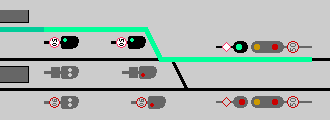
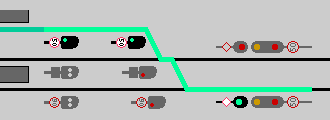
On lines with ATC, the Platform Exit Signals show "Proceed" or "Proceed Through" depending of the state of the signal ahead:
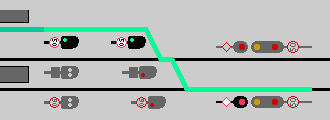

Speed Indicators are inactive (extinguished) and Speed Boards do not apply to other Platform Exit Signal indications than "Proceed" or "Proceed Through":
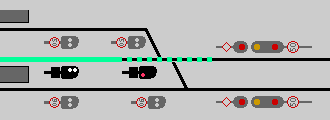
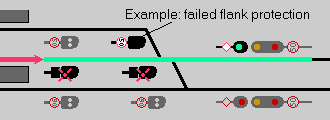

Entry, Exit and Automatic Block Signals all show the "Conditional Stop" aspect to trains permitted to proceed on cab signal indication. Platform Exit Signals, however, show the aspect "Pass" aspect, normally associated with switch routes (since the cab signaling routes techncally are switch routes):

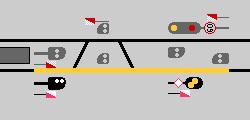
Trains with failed cab signals run on ordinary signal aspects.



Some older interlockings dating from before the Platform Exit Signal have later been added similar Platform Exit Signals, but to be used as end points for short entry routes without safety overlap.
As most of these mixed interlockings have either been replaced, or the Exit Route Signals converted to Platform Exit Signals, this mixed signal configuration is no longer in use.
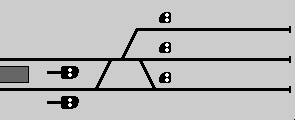
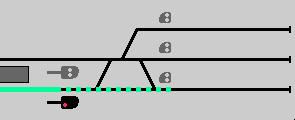
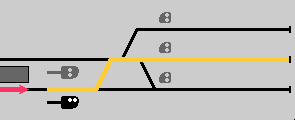
![]()
| [Back] | [Home] |
![]()